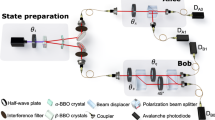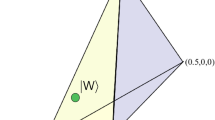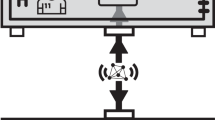Abstract
In contrast to classical physics, quantum theory demands that not all properties can be simultaneously well defined; the Heisenberg uncertainty principle is a manifestation of this fact1. Alternatives have been explored—notably theories relying on joint probability distributions or non-contextual hidden-variable models, in which the properties of a system are defined independently of their own measurement and any other measurements that are made. Various deep theoretical results2,3,4,5 imply that such theories are in conflict with quantum mechanics. Simpler cases demonstrating this conflict have been found6,7,8,9,10 and tested experimentally11,12 with pairs of quantum bits (qubits). Recently, an inequality satisfied by non-contextual hidden-variable models and violated by quantum mechanics for all states of two qubits was introduced13 and tested experimentally14,15,16. A single three-state system (a qutrit) is the simplest system in which such a contradiction is possible; moreover, the contradiction cannot result from entanglement between subsystems, because such a three-state system is indivisible. Here we report an experiment with single photonic qutrits17,18 which provides evidence that no joint probability distribution describing the outcomes of all possible measurements—and, therefore, no non-contextual theory—can exist. Specifically, we observe a violation of the Bell-type inequality found by Klyachko, Can, Binicioğlu and Shumovsky19. Our results illustrate a deep incompatibility between quantum mechanics and classical physics that cannot in any way result from entanglement.
This is a preview of subscription content, access via your institution
Access options
Subscribe to this journal
Receive 51 print issues and online access
$199.00 per year
only $3.90 per issue
Buy this article
- Purchase on Springer Link
- Instant access to full article PDF
Prices may be subject to local taxes which are calculated during checkout



Similar content being viewed by others
References
Heisenberg, W. The Physical Principles of Quantum Theory 13–52 (Univ. Chicago Press, 1930)
Specker, E. Die Logik nicht gleichzeitig entscheidbarer Aussagen. Dialectica 14, 239–246 (1960)
Bell, J. S. On the problem of hidden variables in quantum mechanics. Rev. Mod. Phys. 38, 447–452 (1966)
Kochen, S. & Specker, E. P. The problem of hidden variables in quantum mechanics. J. Math. Mech. 17, 59–87 (1967)
Gleason, A. M. Measures on the closed subspaces of a Hilbert space. J. Math. Mech. 6, 885–893 (1957)
Mermin, N. D. Simple unified form for the major no-hidden-variables theorems. Phys. Rev. Lett. 65, 3373–3376 (1990)
Peres, A. Two simple proofs of the Kochen-Specker theorem. J. Phys. A 24, L175–L178 (1991)
Peres, A. Quantum Theory: Concepts and Methods Ch. 7 (Kluwer, 1993)
Clifton, R. Getting contextual and nonlocal elements-of-reality the easy way. Am. J. Phys. 61, 443–447 (1993)
Cabello, A., Estebaranz, J. M. & García-Alcaine, G. Bell-Kochen-Specker theorem: a proof with 18 vectors. Phys. Lett. A 212, 183–187 (1996)
Huang, Y.-F., Li, C.-F., Zhang, Y.-S., Pan, J.-W. & Guo, G.-C. Experimental test of the Kochen-Specker theorem with single photons. Phys. Rev. Lett. 90, 250401 (2003)
Bartosik, H. et al. Experimental test of quantum contextuality in neutron interferometry. Phys. Rev. Lett. 103, 040403 (2009)
Cabello, A. Experimentally testable state-independent quantum contextuality. Phys. Rev. Lett. 101, 210401 (2008)
Kirchmair, G. et al. State-independent experimental test of quantum contextuality. Nature 460, 494–497 (2009)
Amselem, E., Rådmark, M., Bourennane, M. & Cabello, A. State-independent quantum contextuality with single photons. Phys. Rev. Lett. 103, 160405 (2009)
Moussa, O., Ryan, C. A., Cory, D. G. & Laflamme, R. Testing contextuality on quantum ensembles with one clean qubit. Phys. Rev. Lett. 104, 160501 (2010)
Lapkiewicz, R. et al. Most Basic Experimental Falsification of Non-Contextuality (Poster, 13th Workshop on Quantum Information Processing, 2010)
Lapkiewicz, R. et al. Experimental Non-Classicality of an Indivisible System. Abstr. Q29.00008 (41st Annu. Meeting Div. Atom. Mol. Opt. Phys., American Physical Society, 2010)
Klyachko, A. A., Can, M. A., Biniciog˘lu, S. & Shumovsky, A. S. Simple test for hidden variables in spin-1 systems. Phys. Rev. Lett. 101, 20403 (2008)
Gühne, O. et al. Compatibility and noncontextuality for sequential measurements. Phys. Rev. A 81, 22121 (2010)
Acknowledgements
This work was supported by the ERC (Advanced Grant QIT4QAD), the Austrian Science Fund (Grant F4007), the EC (Marie Curie Research Training Network EMALI), the Vienna Doctoral Program on Complex Quantum Systems and the John Templeton Foundation. We acknowledge A. A. Klyachko for discussion of the proposal made in ref. 19; M. Hentschel, M. Kacprowicz and G. J. Pryde for discussions of technical issues; A. Cabello, S. Osnaghi, H. M. Wiseman and M. Z˙ukowski, with whom we discussed the conceptual issues; and M. Nespoli for help during the early stages of the experiment.
Author information
Authors and Affiliations
Contributions
All authors contributed to the design of the experiment. R.L., P.L. and C.S. performed the experiment and all authors wrote the manuscript.
Corresponding author
Ethics declarations
Competing interests
The authors declare no competing financial interests.
Supplementary information
Supplementary Information
The file contains Supplementary Text and Data 1-5, Supplementary Figure 1 with a legend and Supplementary Table 1. (PDF 522 kb)
Rights and permissions
About this article
Cite this article
Lapkiewicz, R., Li, P., Schaeff, C. et al. Experimental non-classicality of an indivisible quantum system. Nature 474, 490–493 (2011). https://doi.org/10.1038/nature10119
Received:
Accepted:
Published:
Issue Date:
DOI: https://doi.org/10.1038/nature10119
This article is cited by
-
Classification of data with a qudit, a geometric approach
Quantum Machine Intelligence (2024)
-
Self-testing of a single quantum system from theory to experiment
npj Quantum Information (2023)
-
Quantum Contextuality is in Good Agreement with the Delayed-Choice Method
International Journal of Theoretical Physics (2023)
-
High cooperativity coupling to nuclear spins on a circuit quantum electrodynamics architecture
Communications Physics (2022)
-
The Degree of Quantum Contextuality in Terms of Concurrence for the KCBS Scenario
International Journal of Theoretical Physics (2022)
Comments
By submitting a comment you agree to abide by our Terms and Community Guidelines. If you find something abusive or that does not comply with our terms or guidelines please flag it as inappropriate.



